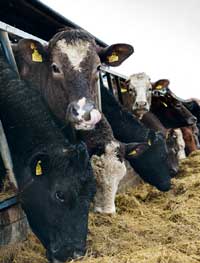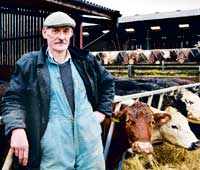Disease check: Controlling BVD in beef herds

With persistently infected animals responsible for 85% of BVD transmission, culling these animals and protecting breeding stock through vaccination is essential to control disease spread, according to vet Keith Cutler, Endell Vet Group.
“Persistently infected animals (PIs) are the main source of BVD infection, with just 15% of transmission spread from acute infection,” he explains.
A PI is formed when a cow becomes infected within the first third of pregnancy. Her calf will always be infected and shed the disease. Equally a PI cow will always produce a PI calf.
“The only way to deal with a PI is to cull them out of the herd and reduce the rate of transmission.”
And this strategy has been adopted by Hampshire beef farmer Kelvin Green (pictured below) who farms 150 spring and 60 autumn block calvers at Cowlease Farm, Romsey.
The herd has a dairy cross base which is crossed to Simmental and then to Aberdeen Angus. The farm also has a small herd of pedigree Aberdeen Angus which they use to breed their own bulls.
 After identifying a PI in the bulling heifers about four years ago we started vaccinating the whole herd as part of an ongoing drive to improve herd health, explains Mr Green.
After identifying a PI in the bulling heifers about four years ago we started vaccinating the whole herd as part of an ongoing drive to improve herd health, explains Mr Green.
“We used to buy in replacements, but after a TB scare with bought-in stock, we decided something had to be done.” Since then, the farm has moved towards managing a closed herd and controlling BVD and leptospirosis.
Initially a small, sickly heifer was singled out for poor performance and blood tests identified her as a PI, explains Mr Cutler. “PIs are not always obvious, but can show themselves as runty animals that may fail to respond to treatment.
“Once a PI has been identified, they must be culled immediately. You then know BVD is present in the herd, so the next step is to prevent more PIs from being born and vaccinate.
“The key is to prevent heifers from becoming infected and protect the unborn calf. The strategy undertaken at Cowlease Farm is a good example of correct testing and vaccination policy. When heifers are selected as replacements they are then tested to see whether they are a PI.”
After tests come back negative and before first service, these heifers are vaccinated for the first time. “It is vital vaccination is carried out before service. Animals need to be protected before pregnancy and specifically in the first third of pregnancy.”
But the way you tackle disease will be farm specific, he stresses. “The quickest way to control BVD is to test all cattle at once and cull all PIs, but this is extremely costly.”
The second option, and the one implemented by Mr Green is to accept BVD is in the herd, but test replacement animals and vaccinate all breeding stock to prevent PIs from being born. And when a homebred heifer is identified as being a PI, the next step is to find and test her dam.
“Over a period of time the whole herd will have been tested, but the cost will be spread out.” And in a few years Cowlease Farm will be BVD free.
Having implemented these changes, fertility has shown marked improvements, says Mr Green. “Our calving pattern is now much tighter with most now calving in a six week block. Out of our 150 spring calvers, we only had four that were PD negative.
“And since vaccinating, calves are also more even and we have also seen improvements in calf numbers.”
With about 95% of the national herd endemically infected with BVD and 1-2% of calves born a PI, the risk of buying in infection is extremely high, says Mr Cutler.
“When animals are being bought into a herd with BVD, they must first be tested for virus to see whether they pose a disease risk to the herd.
“When buying in bulls, farmers should seek assurance of the herd’s status and preferably only purchase stock from BVD accredited free herds.” Any bought-in bulls at Mr Green’s are blood tested for virus and antibodies as an extra security measure.
